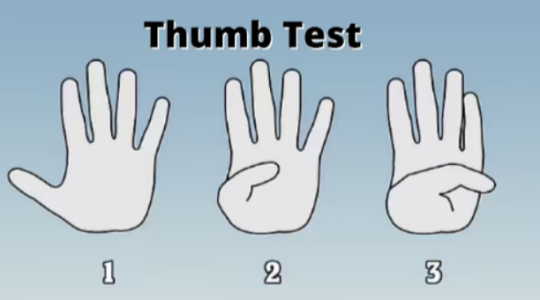This simple thumb test could reveal a hidden heart problem—are you at risk?
- Replies 0
What if a simple movement of your hand could uncover a hidden threat in your heart?
It might sound strange, but doctors say your thumb could be telling you more than you realize.
A viral test shared by a California emergency doctor is grabbing attention for good reason.
It’s quick, free, and could point to a condition that often goes undetected until it’s too late.
Hold your hand up like you’re signaling “stop,” with fingers flat and spread.
Then, stretch your thumb across your palm toward your pinky. If your thumb crosses beyond the edge of your hand, that’s called a positive thumb-palm test.
According to Dr. Joe Whittington, “If it does that is a positive thumb-palm test.”
Dr. Whittington explains that stretchy thumbs could point to stretchy connective tissue throughout your body.
The same stretchiness applies to the tissues in the arteries, he said in a online video.
That includes your aorta, the body’s largest blood vessel and a critical pathway from the heart.
A weak or stretched aorta is more prone to developing an aneurysm—a potentially deadly bulge or rupture.
An aortic aneurysm is often a silent threat that grows slowly over time. Ruptures in the blood vessel are often fatal due to severe internal bleeding, said Dr. Whittington.
The danger is that most aneurysms cause no symptoms until they are about to burst. That’s why early detection—especially using tools like this test—can be life-saving.
Yes, a 2021 study in the American Journal of Cardiology supports it. 60% of people with known aortic aneurysms had a positive palm-thumb test, the researchers found.
The test was administered to 305 patients undergoing cardiac surgery for various reasons.
Those with positive results were far more likely to have a hidden aneurysm.
Dr. Whittington is clear: “Should not freak out.” A positive test doesn’t mean you definitely have a heart condition.
But it’s a helpful flag, especially if you have a family history of heart disease or connective tissue disorders. “It’s worth bringing it up with your doctor so they can diver deeper,” he said.
There are over 200 known disorders that impact connective tissues in the body. These include genetic conditions, autoimmune diseases, and rare vascular syndromes.
The three most common aortic-related connective tissue disorders are Marfan Syndrome, Ehlers-Danlos Syndrome (EDS), and Loeys-Dietz Syndrome, according to the original study.
Also read: Could this 14-year-old’s app save your life? Instantly detect early heart failure in just 7 seconds
Each of these can stretch or weaken arteries and increase rupture risk. Marfan syndrome affects connective tissues throughout the body and is often inherited.
Those with this condition are at up to a 250 times greater risk of aortic dissection, researchers note. People with Marfan often have a tall, thin build and long arms, fingers, or toes.
Other symptoms include heart palpitations, shortness of breath, and vision changes. EDS is a group of genetic disorders that cause overly flexible joints and fragile blood vessels.
It is estimated there are anywhere between 135,000 and 300,000 people in the UK with the condition, according to estimates.
The most common form is hypermobile EDS, which is frequently underdiagnosed. Vascular EDS, however, carries the highest risk for aneurysms.
This is a rare inherited disorder that mostly affects blood vessels. It primarily causes problems with blood vessels and often enlarging the aorta, leading to dissection risk.
People with Loeys-Dietz often show no symptoms until complications arise. Diagnosis typically requires genetic testing and detailed imaging scans.
Most people with aneurysms won’t notice anything until a crisis occurs. But warning signs may include chest, neck, or back pain; coughing or wheezing; and swelling in the head or arms.
Also read: Are you skipping this daily habit? Scientists say it could put your heart at risk
In some cases, people may even cough up blood. If you experience these symptoms, especially with a family history of aneurysms, seek help immediately.
First, stay calm—it’s not a diagnosis. But do mention it to your doctor, who may explore further with imaging or family history checks.
Doctors may spot them during routine tests and offer treatments to prevent damage, like blood pressure meds or preventive surgery.
The key is early action and open communication with your healthcare team.
The risk of aneurysms and connective tissue breakdown increases with age.
Many of these disorders go undetected until later in life.
The thumb test is fast, easy, and costs nothing—yet it might start a life-saving conversation.
Knowing the signs can save lives, researchers noted.
Read next: Tossing and turning? This doctor-backed method might finally help

Have you or a loved one tried this test? Did it tell you something new about your health? Do you have experience with connective tissue disorders or sudden heart problems in your family? Share your story—it may help someone else take action in time.
It might sound strange, but doctors say your thumb could be telling you more than you realize.
A viral test shared by a California emergency doctor is grabbing attention for good reason.
It’s quick, free, and could point to a condition that often goes undetected until it’s too late.
Hold your hand up like you’re signaling “stop,” with fingers flat and spread.
Then, stretch your thumb across your palm toward your pinky. If your thumb crosses beyond the edge of your hand, that’s called a positive thumb-palm test.
According to Dr. Joe Whittington, “If it does that is a positive thumb-palm test.”
Dr. Whittington explains that stretchy thumbs could point to stretchy connective tissue throughout your body.
The same stretchiness applies to the tissues in the arteries, he said in a online video.
That includes your aorta, the body’s largest blood vessel and a critical pathway from the heart.
A weak or stretched aorta is more prone to developing an aneurysm—a potentially deadly bulge or rupture.
An aortic aneurysm is often a silent threat that grows slowly over time. Ruptures in the blood vessel are often fatal due to severe internal bleeding, said Dr. Whittington.
The danger is that most aneurysms cause no symptoms until they are about to burst. That’s why early detection—especially using tools like this test—can be life-saving.
Yes, a 2021 study in the American Journal of Cardiology supports it. 60% of people with known aortic aneurysms had a positive palm-thumb test, the researchers found.
The test was administered to 305 patients undergoing cardiac surgery for various reasons.
Those with positive results were far more likely to have a hidden aneurysm.
Dr. Whittington is clear: “Should not freak out.” A positive test doesn’t mean you definitely have a heart condition.
But it’s a helpful flag, especially if you have a family history of heart disease or connective tissue disorders. “It’s worth bringing it up with your doctor so they can diver deeper,” he said.
There are over 200 known disorders that impact connective tissues in the body. These include genetic conditions, autoimmune diseases, and rare vascular syndromes.
The three most common aortic-related connective tissue disorders are Marfan Syndrome, Ehlers-Danlos Syndrome (EDS), and Loeys-Dietz Syndrome, according to the original study.
Also read: Could this 14-year-old’s app save your life? Instantly detect early heart failure in just 7 seconds
Each of these can stretch or weaken arteries and increase rupture risk. Marfan syndrome affects connective tissues throughout the body and is often inherited.
Those with this condition are at up to a 250 times greater risk of aortic dissection, researchers note. People with Marfan often have a tall, thin build and long arms, fingers, or toes.
Other symptoms include heart palpitations, shortness of breath, and vision changes. EDS is a group of genetic disorders that cause overly flexible joints and fragile blood vessels.
It is estimated there are anywhere between 135,000 and 300,000 people in the UK with the condition, according to estimates.
The most common form is hypermobile EDS, which is frequently underdiagnosed. Vascular EDS, however, carries the highest risk for aneurysms.
This is a rare inherited disorder that mostly affects blood vessels. It primarily causes problems with blood vessels and often enlarging the aorta, leading to dissection risk.
People with Loeys-Dietz often show no symptoms until complications arise. Diagnosis typically requires genetic testing and detailed imaging scans.
Most people with aneurysms won’t notice anything until a crisis occurs. But warning signs may include chest, neck, or back pain; coughing or wheezing; and swelling in the head or arms.
Also read: Are you skipping this daily habit? Scientists say it could put your heart at risk
In some cases, people may even cough up blood. If you experience these symptoms, especially with a family history of aneurysms, seek help immediately.
First, stay calm—it’s not a diagnosis. But do mention it to your doctor, who may explore further with imaging or family history checks.
Doctors may spot them during routine tests and offer treatments to prevent damage, like blood pressure meds or preventive surgery.
The key is early action and open communication with your healthcare team.
The risk of aneurysms and connective tissue breakdown increases with age.
Many of these disorders go undetected until later in life.
The thumb test is fast, easy, and costs nothing—yet it might start a life-saving conversation.
Knowing the signs can save lives, researchers noted.
Read next: Tossing and turning? This doctor-backed method might finally help
Key Takeaways
- A one-minute thumb-palm test may identify people at higher risk for deadly aortic aneurysms, especially those with stretchier connective tissue.
- In one study, 60% of patients with known aortic aneurysms had a positive result, where the thumb extends beyond the palm.
- Conditions like Marfan syndrome, Ehlers-Danlos, and Loeys-Dietz greatly increase aortic risk and are often undiagnosed.
- While not a diagnosis, the test can prompt early screening, which may lead to life-saving interventions.







